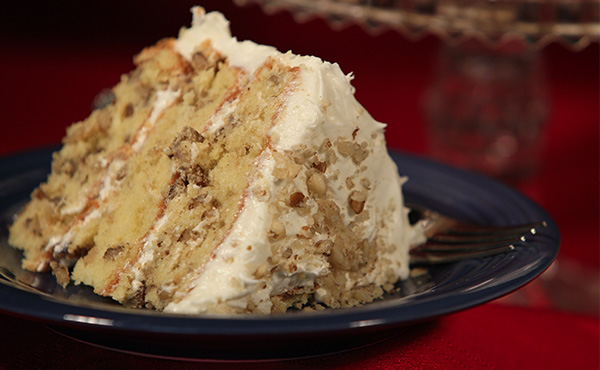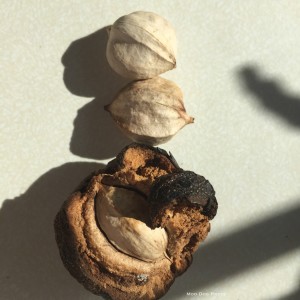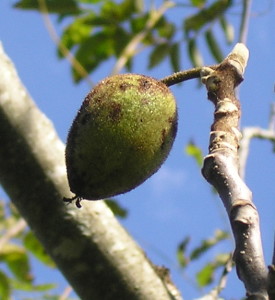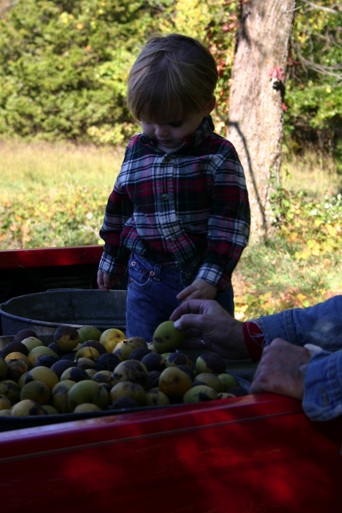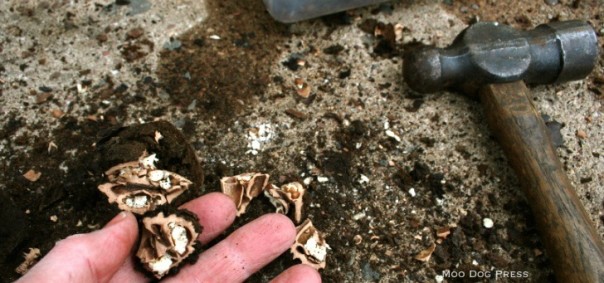Black Walnuts, Hickory, Butternut: Wild Bounty, Good Eating, More Lore
Go ahead, kick away those orbs of green. Native black walnuts take work to reveal the treasure within. Those in the know will be gathering the bounty as the walnuts ripen and fall. Right now.
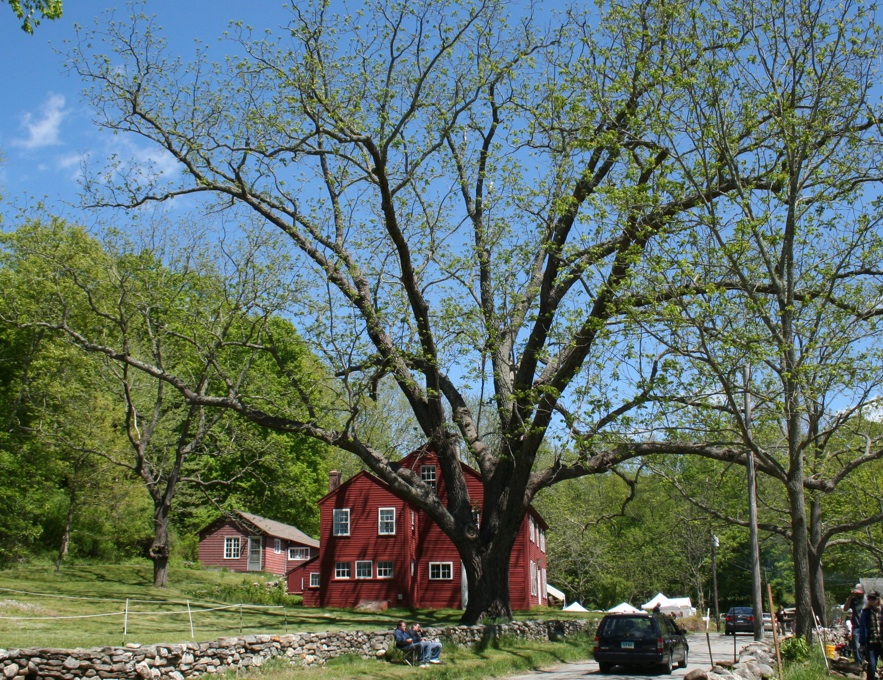
Connecticut champion black walnut tree – planted long ago by a squirrel or by human, the tree was valued by the farmer who called this 1715 saltbox in Scotland home and by the descendants who followed. Seen here in late spring years ago. © Chris Brunson
A grove of black walnuts? Treasure, indeed.
The trees do produce a substance known as juglone, which deters some plants within its drip line. For more recipes and news about native nut crops and black walnuts, visit Hammons Nut Emporium, which offers a wealth of knowledge.
Mmm. Think ahead and gather the black walnuts now to enjoy the rewards in months ahead.
Hammons Fancy Black Walnut Cake recipe
1/2 cup butter, softened
1/2 cup shortening
2 cups sugar
5 eggs, separated
1 cup buttermilk
2 cups all purpose flour
1 teaspoon vanilla
1 1/2 cups black walnuts
1 3-ounce can flaked coconut
1/2 teaspoon cream of tartar
1 teaspoon baking soda
Cream butter and shortening. Gradually add sugar, beating until light and fluffy and sugar is dissolved. Add egg yolks and beat well. Combine soda and buttermilk: stir until soda is dissolved. Add flour to creamed mixture alternately with buttermilk mixture, beginning and ending with flour. Add vanilla, Black walnuts and coconut: stir thoroughly. Beat egg whites (at room temperature) with cream of tartar until stiff peaks form, then fold into batter. Pour batter into three greased and floured nine-inch pans. Bake at 350 for 30 minutes, then remove from pans and finish cooling. Ice with cream cheese frosting. Optional, sprinkle top of cake with black walnuts. Frosting:
3/4 cup butter, softened
1 3-ounce package cream cheese, softened
1 10-ounce package cream cheese, softened
6 3/4 cups powdered sugar
1 1/2 teaspoons vanilla
Cream butter and cream cheese, then add sugar gradually and beat until light and fluffy. Add vanilla.
Native nut trees are valuable and prized and shed a bountiful crop for those in the know – black walnut, hickories, butternuts. While transferring some young walnut trees (likely “planted” by a squirrel) and thinking about “nut picking” – the hunt, things discovered while out and about that cannot be predicted. Mushrooms, hidden deer paths picked out in fallen leaves, small streams, forgotten stone walls with flat ledges perfect for sitting and thinking, enjoying a hard-boiled egg or an apple.
Shagbark hickory nuts this year are also plentiful. More elusive are the butternuts as many people no longer know the value of this tree and sometimes cut them down. The species is also taking a beating by diseases. Picking by hand takes time and effort – the haul is worth it. (More about the nutrition values below.)
My mother and father are gone now, but their legacy remains – part of that is they loved going “nut picking” in a station wagon loaded up with their children, containers, a cooler packed full of lunch ingredients.
The resulting memories are etched on my soul. Wearing warm hooded sweatshirts with pockets perfect for carrying nuts, then sitting on stone walls to crack open the nuts (not crush them) and patiently pick out sweet kernels contained within the shell bits. As a result, I treasure native nut trees and when thinning a grove leave these valued trees – especially the shagbark hickory and toothsome (but tougher to crack) black walnut. Grow and enjoy the trees in all seasons, but you have to beat resident squirrels (or other aficionados of the delectable wild crop) to the bounty. Right now, August, the green walnuts are falling and the outer husk has a pleasant spicy aroma.
Officially called Juglans nigra, the eastern black walnut is a native species valued for its fruit, encased in a green husk.
Packed with nutrition, according to The International Tree Nut Council Nutrition Research & Education Foundation, recent findings show tree nut consumption is associated with “better adiposity measures and cardiovascular and metabolic syndrome health risk factors” in U.S. adults.” What does that actually mean? Lower body weight. For the many other benefits to consuming nuts, see this link to nuthealth.org where you can plug in any variety you like and then read the results.
Farms often have stands of nut trees along pasture walls and property lines – trees valued for wood and timber as well as the nut crop. (Not every year is a productive one.) Some suburban homeowners view a black walnut tree as “messy” – the hard nuts will shoot out like projectiles from the blades of a mower passing over them. They fall to plonk on vehicles and all below at random, which can be startling.
The process to get to the nutmeats only begins with the gathering. Time and persistence is required as the green-black covering must first dry and be removed to get to the walnut. As they naturally decay, small white grubs or worms aid the procedure. These may be unsightly, but are efficient. Be tenacious.
Good eating? You bet.
Try to remove the green covering by hand and the tannin-rich husks will impart a long-lasting stain to your palms. At this point many people just chuck the whole idea; it's not for the faint-hearted. For those who persist, the hard-shelled ebony walnut emerges. Since the moisture-rich tree embryo (that's what a nut is after all) is fresh, more drying – and time – is necessary. Age improves the rich and distinctive taste.
And a black walnut is a tough nut to crack. Really. It takes patience and practice to learn the art of a hard whack to split the shell but not crush the treasure inside. The goal is to cleave each clean in half. (Imperfect shells can be picked over by using a large opened safety pin – my mother was an expert in getting every edible shred possible to make chocolate chip cookies from scratch for those who love them – she preferred hickories.)
“About 65% of the annual wild harvest comes from the U.S. state of Missouri and the largest processing plant is operated by Hammons Products in Stockton, Missouri. The black walnut nutmeats are used as an ingredient in food, particularly ice cream, while the shell is used commercially in abrasive cleaning, cosmetics, and oil well drilling and water filtration.” – Wikipedia
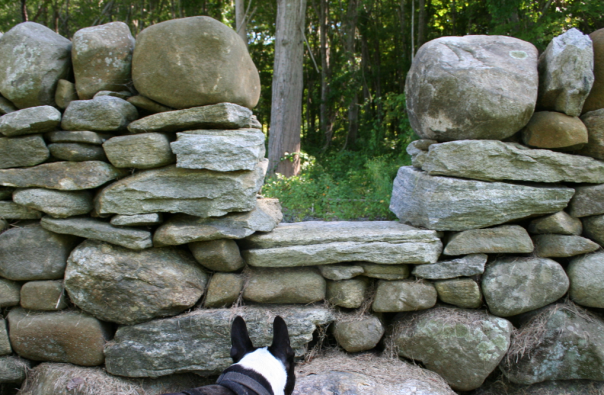
Stone wall stile. Walls and boundaries on maps are information used to “see” into the past. Look for prized nut trees along the walls.
Hammons, a family-owned company, is the leading processor and supplier of black walnuts in the United States – and sells pure nutmeats by the pound or in the shell.
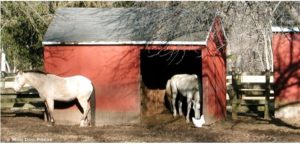
Black walnuts are also prized for “gunstocks, furniture, flooring, paddles, coffins, and a variety of other wood products. Due to its value, forestry officials often are called on to track down walnut poachers; in 2004, DNA testing was used to solve one such poaching case, involving a “55-foot tree worth US $2,500” according to Wikipedia.
How much is a single black walnut tree worth? That depends on many factors.
“Black walnut logs bring premium prices, and have since the 1700s, with single trees bringing up to $20,000. Bruce Thompson, author of ‘Black Walnut For Profit' — estimates a mature stand of black walnut trees can bring about $100,000 per acre in timber value alone.” (March 26, 2021)
Editor's note: Though this story appeared earlier this year, worth reminding all out there to forage and harvest these valued trees. Also, as the pandemic takes another lap, stick to your science. Masks, distance, get vaccinated if you have not already done so.
Here is a lesson from history:
Smarter back then? I learned recently that John Downs (of Milford CT’s “Minuteman House”) traveled to Salem, NY in 1776 or 77 to get his inoculation https://t.co/JAtXGsDIXc Milford, CT River Park Historic District: A River Walk Through It https://t.co/QtZuw4lVlQ https://t.co/BaFPsR6zxY
— John C Watson (@watsonjohnc) August 4, 2021

